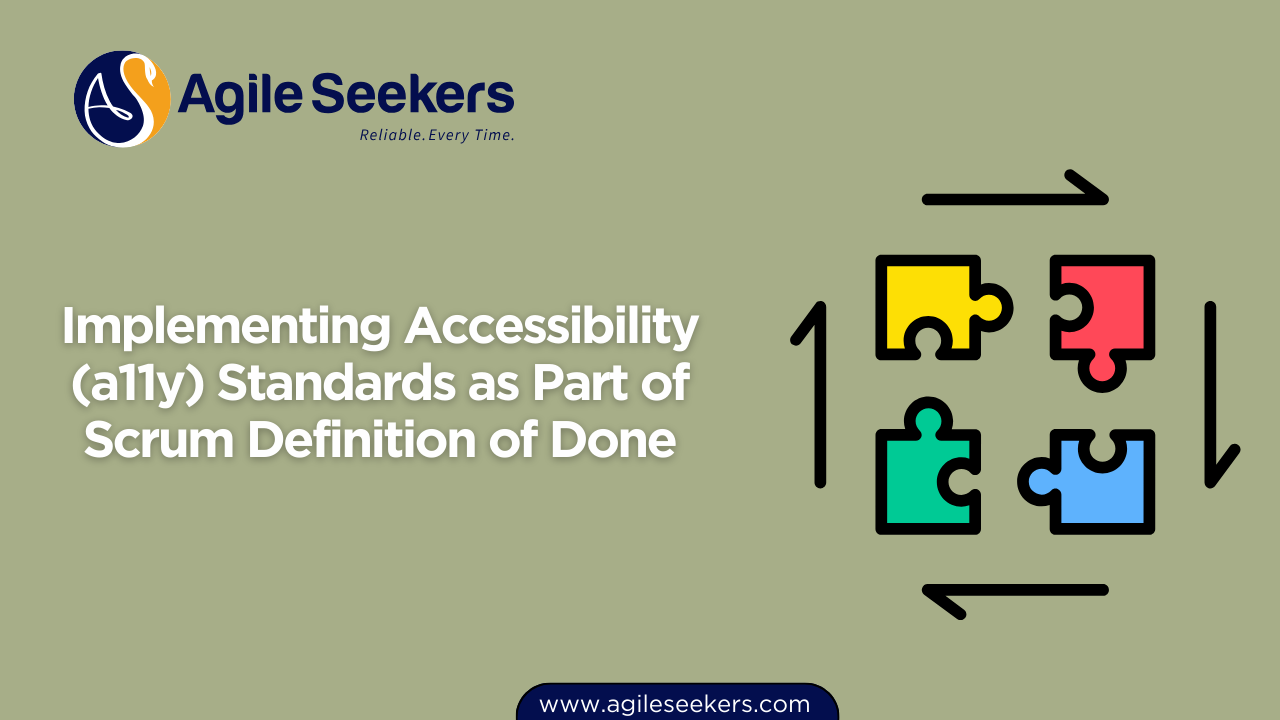Implementing Accessibility (a11y) Standards as Part of Scrum Definition of Done

Accessibility (a11y) is not just a compliance requirement. It’s a key part of creating inclusive, user-friendly digital products. Integrating accessibility standards into the Scrum Definition of Done (DoD) ensures that accessibility isn’t treated as an afterthought but becomes a shared responsibility across the development team.
This post explains how to embed a11y standards into the Scrum DoD, why it matters, and practical steps to get your team aligned.
Why Accessibility Should Be Part of the DoD
The Definition of Done outlines the conditions that must be met for a product backlog item to be considered complete. When accessibility is missing from this checklist, teams risk shipping features that exclude users with disabilities.
Here’s what can happen when accessibility is excluded:
-
Users who rely on screen readers can't navigate the application.
-
Color-blind users face usability issues due to poor color contrast.
-
Keyboard-only users can’t interact with key components.
-
You miss compliance with regulations like WCAG 2.1, ADA, or Section 508.
By incorporating accessibility into the DoD, Scrum teams proactively create inclusive products, reduce rework, and build trust with a broader user base.
Key Accessibility Standards to Include
While the Web Content Accessibility Guidelines (WCAG) provide a comprehensive framework, Scrum teams should focus on pragmatic and testable standards in their DoD:
-
Semantic HTML: Use appropriate tags (e.g.,
<button>,<header>,<nav>). -
Keyboard Navigation: Ensure all functionality is accessible via keyboard.
-
ARIA Roles: Apply only when necessary and correctly.
-
Color Contrast: Maintain a minimum contrast ratio of 4.5:1 for text.
-
Alt Text: Provide descriptive alt text for images.
-
Focus Management: Manage focus for modal dialogs, navigation, etc.
-
Skip Links: Provide skip navigation options.
-
Error Identification: Clearly label form errors with accessible cues.
-
Responsive Design: Ensure accessibility across device sizes.
-
Screen Reader Compatibility: Test with tools like NVDA, JAWS, or VoiceOver.
Include these standards as part of the acceptance criteria for user stories.
How to Embed Accessibility in the Scrum Process
1. Update the Definition of Done
Clearly document accessibility checkpoints in your team's DoD. Example:
"All user-facing features must meet WCAG 2.1 Level AA compliance, support keyboard navigation, include appropriate ARIA roles, and pass screen reader testing."
2. Build Accessibility into User Stories
Include accessibility as part of acceptance criteria:
"As a keyboard-only user, I should be able to navigate all interactive elements using tab and shift+tab."
3. Use Accessible Component Libraries
Encourage the use of design systems and libraries (like Material UI or GOV.UK Design System) that prioritize accessibility.
4. Conduct Regular Accessibility Audits
Use tools like:
Make auditing part of the Sprint Review or Definition of Done validation process.
5. Test with Real Assistive Tech
Automated tools catch only ~30% of issues. Combine them with manual testing:
-
Use NVDA on Windows.
-
Use VoiceOver on macOS and iOS.
-
Try TalkBack on Android.
6. Train the Team
Accessibility is a shared responsibility. Offer workshops or microlearning sessions. Consider integrating this into your CSM training or pairing sessions with QA.
7. Sprint Retrospective Improvements
Use retrospectives to reflect on how accessibility efforts are working. Improve your DoD iteratively.
Sample Accessibility Checklist for Scrum DoD
Here’s a quick reference accessibility checklist to include in your DoD:
-
Semantic HTML structure
-
Color contrast >= 4.5:1
-
Keyboard navigable
-
Focus visible and logical
-
Screen reader tested
-
Descriptive alt text for images
-
Forms labeled with associated instructions and errors
-
ARIA roles used correctly
-
Skip to content link present
-
Resizable text without breaking layout
This can be added to your Definition of Done wiki or Jira checklist.
Benefits of Making Accessibility a DoD Standard
-
Reduced Technical Debt: Accessibility fixes are expensive post-release.
-
Improved Usability: Good accessibility often improves overall UX.
-
Legal Compliance: Stay ahead of laws like ADA and EN 301 549.
-
Inclusive Experience: Serve all users, regardless of ability.
-
Better Team Collaboration: Accessibility work encourages cross-functional collaboration.
Accessibility in SAFe Scrum Environments
Even in a SAFe Scrum Master context, accessibility should be treated as a non-negotiable quality standard. As part of SAFe Scrum Master training, teams are encouraged to include such quality criteria in the Team PI Objectives and DoD.
Final Thoughts
Embedding accessibility into the Scrum Definition of Done isn’t just about compliance. It’s about creating products that respect user diversity from the start. Make it visible. Make it testable. Make it standard.
For teams new to accessibility, start small but be consistent. Integrate accessibility with every Sprint cycle. Treat it as a core quality metric just like performance or security.
Learn more about accessibility-aligned agile practices through certified scrum master training or SAFe Scrum Master certification programs that guide teams on how to embed quality practices into iterative delivery.
Also read - Building Cross-Browser Compatibility as a Sprint Goal
Also see - Using Static Code Analysis Tools as Part of Sprint Reviews




















